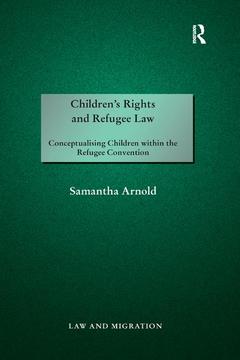Description
Children's Rights and Refugee Law
Conceptualising Children within the Refugee Convention
Law and Migration Series
Author: Arnold Samantha
Language: English
Subjects for Children's Rights and Refugee Law:
Keywords
Refugee Law; Refugee Convention; Child refugee law; Children's rights; Convention on the Rights of the Child; Children’s Rights; Protection Rights; Provision Rights; Refugee Case Law; Child Refugee; Child Specific Forms; Social Group Ground; Refugee Protection; Participation Rights; Child Applicant; International Children’s Rights; Refugee Discourse; Political Opinion Grounds; RRT; CRC Right; Convention Grounds; Human Rights; CEDAW; Limited Case Law; Violated; Part Iii; CRC State; International Refugee Law
Publication date: 03-2019
· 15.6x23.4 cm · Paperback
Publication date: 08-2017
· 15.6x23.4 cm · Hardback
Description
/li>Contents
/li>Readership
/li>
Children make up half of the world?s refugees and over 40 per cent of the world?s asylum seekers. However, children are largely invisible in historical and contemporary refugee law. Furthermore, there has been very limited interaction between the burgeoning children?s rights framework, in particular the Convention on the Rights of the Child (CRC), and the 1951 Convention relating to the Status of Refugees (Refugee Convention). This book explores the possibility of a children?s rights approach to the interpretation of the Refugee Convention and within that what such an approach might look like.
In order to construct a children?s rights approach, the conceptualisations of children outside the legal discipline, within international children?s rights law and then within refugee law and refugee discourse are analysed. The approach taken is socio-legal and comparative in nature and the suitability of the Refugee Convention as a framework for the interpretation of child claims is examined. The book analyses to what extent the Refugee Convention is capable of dealing with claims from children based on the modern conceptualisation of children, which is underscored by two competing ideologies: the child as a vulnerable object in law to be protected and the child as subject with rights and the capacity to exercise their agency. The influence each regime has had on the other is also analysed. The work discusses how a children?s rights approach might improve outcomes for child applicants.
The book makes an original contribution to child refugee discourse and as such will be an invaluable resource for academics, researchers and policymakers working in the areas of migration and asylum law, children?s rights and international human rights law.
Chapter 1 Introduction
Introduction
A dichotomy: children’s rights and refugee law
A children’s rights approach
Building upon the ‘human rights approach’
Invisibility in refugee law
Locating children’s rights in refugee law: Article 6 and the ‘Three Ps Approach’
Methodology of analysis
Chapter 2 Children, childhood and refugee law
Abstract
Introduction
Indicators of childhood and being a child and refugee law
A paradigm shift: the emergence of childhood
The modern children’s rights movement
The beginning of the Children’s Rights Movement
Global childhood
Conflicts within the paradigm shift: an externalisation of rights, romanticism and the role of the family
A conceptualisation of childhood
Limitation to the modern conceptualisation of children's rights
Conclusion
Chapter 3 International Children’s Rights Law
Abstract
Introduction
Origins of children’s rights in international law
Convention on the Rights of the Child 1989 and life, survival and development
Provisional rights
Health
Standard of living
Education
Non-discrimination
Protection rights
Labour exploitation
Other forms of economic exploitation
Involvement in other illicit trades
Military conscription
Child marriage
Other non-economic forms of harm
Participation rights
Agency in the Convention on the Right of the Child
Determining agency
Right to be heard
The role of the family in the Convention on the Rights of the Child and provisional, protection and participation rights
Children’s rights and refugee law – an indirect link?
Conclusions
Chapter 4 Children in the development of refugee law
Abstract
Introduction
Children and the beginnings of international human rights law (pre-1951)
Beginnings of refugee law
The historical trajectory of children in the refugee paradigm
Modern refugee law under the United Nations
Conclusion
Chapter 5 A children’s rights approach to refugee law?
Abstract
Introduction
Part I
Context setting
Children within the Refugee Convention and the need for a cross-treaty interpretive approach: some assumptions
Bridging the gap: treaty interpretation
The challenge of implementing international law
International law as national guidance
The object and purpose of the Refugee Convention
The object and purpose of the Convention on the Rights of the Child
Conclusion on objects and purposes
A children’s rights approach – justification through UN Guidance
United Nations High Commissioner for Refugees
Committee on the Rights of the Child
Challenges in the interpretation of the Refugee Convention in respect of children’s rights
Part II
A brief introduction to persecution
Persecution and children
Actors of persecution and protection and the role of the family
Children who are not eligible for protection: exclusion
Convention grounds
Conclusion
Chapter 6 Constructing a children’s rights approach: the application of children’s rights in refugee law
Abstract
Introduction
Challenges to consistency in the interpretation of child refugee claims
Part I
Provisional rights and refugee protection
Family
Education
Conclusion on provisional rights
Part II
Protection rights and refugee protection
Exploitation
Labour and trafficking
Forced military recruitment and protection of children during conflict
Involvement in illicit activities – gangs
Other forms of harm: Indiscriminate violence and torture
Family as persecutor and protector – unattached children
Conclusion on protection rights
Part III
Participation rights and refugee protection
Imputed beliefs
Religion
Political Opinion
Conclusions: participation rights
Conclusions
A Children’s Rights Approach
Chapter 7 Conclusions
Abstract
Introduction
Dichotomies
A children’s rights framework
Invisibility in refugee law
A bourgeoning children’s rights approach to the interpretation of the Refugee Convention
Limited case law
A children’s rights barometer for persecution: present day case law
A particular convention ground
The findings
The questions
Moving forward
Conclusion




